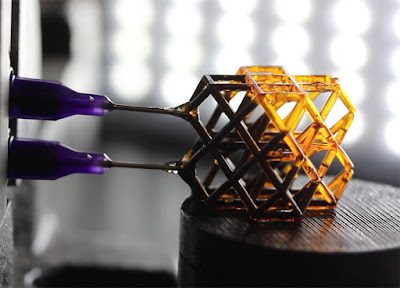In common use, the fourth dimension usually refers to time and another term for four dimensional printing is prints that change (or can be changed) versus time. That leads to the possibility of self-assembly or self-organization which is the hot topic. Machine Design magazine puts it this way:
Think 3D printing, but with increasingly complex materials that will open doors for new product innovation possibilities. This emerging technology will allow the production of three-dimensional objects incorporating a fourth dimension: time. This exponential innovation has the ability to redefine how we design, manufacture, and interact with objects by using “smart” materials to create objects that can self-assemble, reshape themselves, or otherwise react to changing conditions.Skylar Tibbits from MIT, in that TED talk, talks about things like pipes - infrastructure pipes. You've probably seen water pipes run into a new neighborhood, or sewer pipes coming out of that neighborhood. Those are sized for the amount of water they'll be carrying; by proxy, the number of people they'll be serving. Trenches are dug, pipes are laid, and nobody thinks about them until something goes wrong. Perhaps an earthquake and the ground moves, breaking the pipe. More likely, perhaps the pipe isn't big enough for the second new neighborhood going in years after the pipe was originally laid. Then the pipes need to be dug up and enlarged, or newer pipes put in bypassing the older ones.
Tibbits talks about pipes that can adapt; that can enlarge to allow more flow.
In the medical field, doctors are incorporating 4D printing into the neonatal intensive care unit (NICU). Doctors at the University of Michigan’s CS Mott Children’s Hospital have developed a 4D-printed airway splint that prevents infant windpipes from collapsing by automatically expanding as the child grows until the child is strong enough to support him or herself.This barely begins to touch on the possibilities here. Lawrence Livermore National Laboratory (LLNL) researchers developed a magnetic fluid they inject into 3D structures to reinforce them. The fluid changes strength with the applied magnetic field, making structures with customizable strength.
In the aviation field, Airbus is developing programmable carbon fiber into a fuel-saving air inlet component that will cool the engine by adjusting automatically to control airflow. This ability to control airflow also has the potential to transform the cabin experience by mediating pressure and making the space more breathable for passengers. These self-reacting mechanisms will eliminate the need for less-reliable, heavy mechanical control systems, further reducing fuel consumption.
Mancini notes that the technology could be useful for lessening the force of impacts. Automotive seats, for example, could have responsive metamaterials inside along with sensors to detect a crash. The seats would stiffen on impact, potentially reducing passenger motion and injuries. The technology could also be applied to next-generation helmets or neck braces, housings for optical components, and soft robotics, among many other applications.By utilizing dynamic materials like this in 3D printed structures, 4D printing will create objects that are programmed to change strength, shape, or other properties when they encounter the proper stimulus: water, light, heat, electrical current, or magnetism, like this example.
While the thought of producing self-assembling and self-reacting objects may sound whimsical to those who are just now getting a grip on 3D printing, the reality is that 4D printing is estimated to become a $64.5 million market this year, and it will be increasing at an impressive CAGR of 33.2% through 2025.
The LLNL magnetorheological fluid being injected into a hollow 3d printed lattice structure on the right. These “field-responsive mechanical metamaterials” (FRMMs) are a viscous, magnetically responsive fluid (rheology, is the science of deformation and flow; magnetorheology magnetically controlled flow).
It's interesting to see a whole new field being born as we watch.

It occurs to me that 3d printing with metal injection molding material (MIM) could have possibilities.
ReplyDeleteBluetooth adjustable breast implants to match your outfit/mood/partner! Also serve as a pillow speaker.
ReplyDeleteNow THAT idea has serious merit. GENIUS!
DeleteI hate to burst your bubble, but this field has been around for years; the only new thing is the use of 3D printing techniques is making it "cool".
ReplyDeleteAs Ecclesiastes says, there is nothing new under the sun - but all too many writers and publicists don't check to realize that the field or achievement already exists.
With all due respect, "yes, but..."
Delete(1) I started off mentioning a 6 year old video linking 3D printing with self-organizing systems (now called 4D printing), so that's acknowledging this wasn't born yesterday. And
(2) combining existing ideas with 3D printing is what this whole thing is about. Synergy and all.
There isn't much that's done with additive manufacturing that just can't be done with subtractive techniques, maybe nothing, so the question is if we can be more productive (save money, make more of them) with additive techniques.
For example, automatically adjusting engine inlets for airplanes were first developed for the B-70 bomber in the 1960's - WHAT is being done is the same; HOW it is being done is slightly different.
ReplyDelete